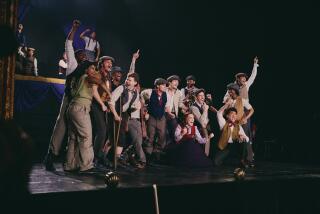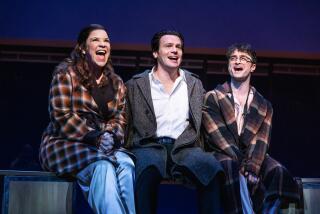Broadway Tries Out PPV Again
NEW YORK — Lights. Camera. Curtain.
That could be the cue Sunday, when the Broadway musical revue “Smokey Joe’s Cafe” is shown on pay-per-view to mark the debut of the Broadway Television Network.
With an almost five-year run to its credit, “Smokey Joe’s Cafe” was the longest-running revue of any kind, even on the Great White Way. Its last day of performance in January was also its first day of filming as the nascent network captured its finale with multiple cameras and surround-sound miking. “These shows,” says BTN President Bruce Brandwen, “are part of thehistorical record.”
The Broadway Television Network also plans a multiyear run, promising to broadcast via cable pay-per-view or digital broadcast satellite 11 more shows over the next three years. Or is it five years? What’s certain is that the new venture has brought together a solid team of administrative power--Kay Koplovitz, founder and former head of USA Networks, as chairman, and award-winning Broadway director Jerry Zaks as artistic director of theater--and an impressive group of investors, including Koplovitz and Citigroup Investors, to back up action with hard cash. The Shubert Organization, Jujamcyn Theaters and SFX Entertainment have also invested in the project--if the venture works, the theaters want a piece of the action.
Broadway’s first bow on pay-per-view occurred in 1982, when Brandwen brought another revue, “Sophisticated Ladies,” to the home screen. Asked why it’s taken so long to repeat the experiment, Brandwen launches into a brief history of the development of pay-per-view. It’s a subject he should know about, since, as a member of Warner Communications’ original QUBE interactive TV experiment in Ohio, he’s been around since the very start of the medium, helping produce Ohio State football games in 1978, the 1982 Cooney-Holmes fight and the Who’s 1982 farewell tour.
Eighteen years later, the Who is still making farewell tours, and pay-per-view is still emerging from its chrysalis.
Response to the original “Sophisticated Ladies,” Brandwen says, was “terrific. We had approximately 95,000 homes” of some 600,000, at the time, with pay-per-view capacity. “At $15 apiece,” he says, “that was about 40% of the top ticket price at the time, which I believe was $32.” “Smokey Joe’s Cafe” will cost viewers $35, keeping in step with inflation; today, a top Broadway ticket can go for $80.
But “Sophisticated Ladies” was “done with an expectation that did not get realized: that there would be greater pay-per-view technology put into more homes.” Instead, Brandwen explains, the cable networks put all their energies into building up subscriber bases for their own services, rather than developing pay-per-view capabilities.
“HBO got the great name,” Brandwen says, “but it’s a misnomer. They’re really a subscription service, not pay-per-view. The concept of pay-per-view is founded on the idea of a box office in the home.”
Because of this focus on subscribers, the goal of 20 million homes with pay-per-view, the minimum number needed to support a significant financial gamble, wasn’t achieved until 1995. Today, there are 45 million homes with pay-per-view capacity. Koplovitz has said that the new network would be successful if it reached just half of 1% of the potential pay-per-view audience.
Yet to date, the medium has been largely devoted to live sporting events--generally a man’s domain. “Pay-per-view has been treated as a backwater of the industry for a long time,” Koplovitz says. “I think there’s a lot of opportunity being left on the table as far as developing quality productions. There’s a real opportunity for pay-per-view to be able to offer targeted programming to specific audiences.” These include the female and family audiences that have been largely overlooked.
Network Looks to Pro Sports’ Example
Koplovitz brings a background in women’s issues, as well as television, to the venture. Since leaving USA Networks in 1998, she’s chaired the National Women’s Business Council; worked to build up the participation of women in the world of venture capital; and taken over as chief executive of Working Woman Network, which publishes Working Woman and Working Mother.
Broadway, of course, has plenty of questions about the possible conflicts of interest involved in broadcasts that could potentially siphon off live ticket-buyers. Negotiating with the unions has been one of the trickiest parts of preparing for the network’s launch.
In response to these fears, Brandwen and his associates point to the much-vaunted model of professional sports on television: Rather than keep people from going to the ballpark, broadcasts of games have boosted attendance. BTN will follow a live-sportscast format, with the theatrical equivalent of pregame shows (hosted, for the “Smokey Joe’s” premiere, by Tony Orlando) and behind-the-scenes vignettes.
There are more concrete examples of the positive impact mass media can have on live theater. “Riverdance,” Brandwen points out, “has appeared a number of times on PBS and has 4 million video sales. And now it’s in an open-ended run on Broadway.” The broadcasts build brand recognition--and reach a lot of people who could never make it to the theater at all.
An overwhelming majority of viewers--”more than 99%,” Brandwen says, “will never come to Broadway and see a Broadway production.”
Does the Experience Translate to TV?
For all the technical wizardry of HDTV and five-channel surround sound, there are still questions about how well a television format can reproduce the Broadway experience. Furthermore, although BTN originally planned to broadcast live, neither “Smokey Joe’s Cafe” nor the second realized project, “Putting It Together,” are currently running on Broadway. ‘Putting It Together” is another revue, devoted to the music of Stephen Sondheim, and it closed this year after a relatively brief run and a mixed critical reception.
For BTN, that show represented a first chance to work with mega-producer Cameron Mackintosh--and to broadcast Carol Burnett, who led the cast. Since the average viewer is more likely to associate Burnett with television than the stage, this seems less a case of Broadway coming to television than of television coming to Broadway.
For the time being, BTN is confining its plans to getting 10 more shows on television. But Brandwen doesn’t rule out the possibility, down the line, of a 24-hour channel that “could bring you shows we originally brought you as pay-per-view.”
A stronger online presence is also planned: BTN has acquired the Web site Theatre.com as well as developing its own site, BroadwayTV.com. “Our vision,” Koplovitz says, “is to be able to bring to the world the electronic face of Broadway.” BTN will be developing that face, one feature at a time, in the months ahead.
More to Read
The biggest entertainment stories
Get our big stories about Hollywood, film, television, music, arts, culture and more right in your inbox as soon as they publish.
You may occasionally receive promotional content from the Los Angeles Times.










